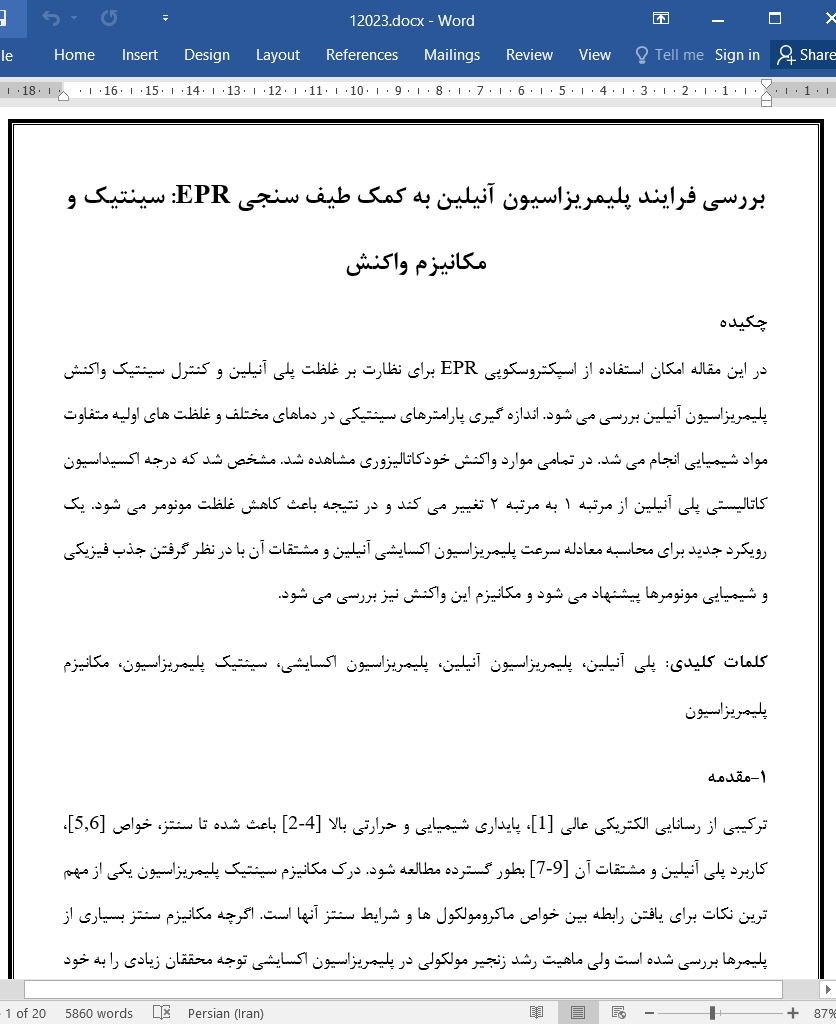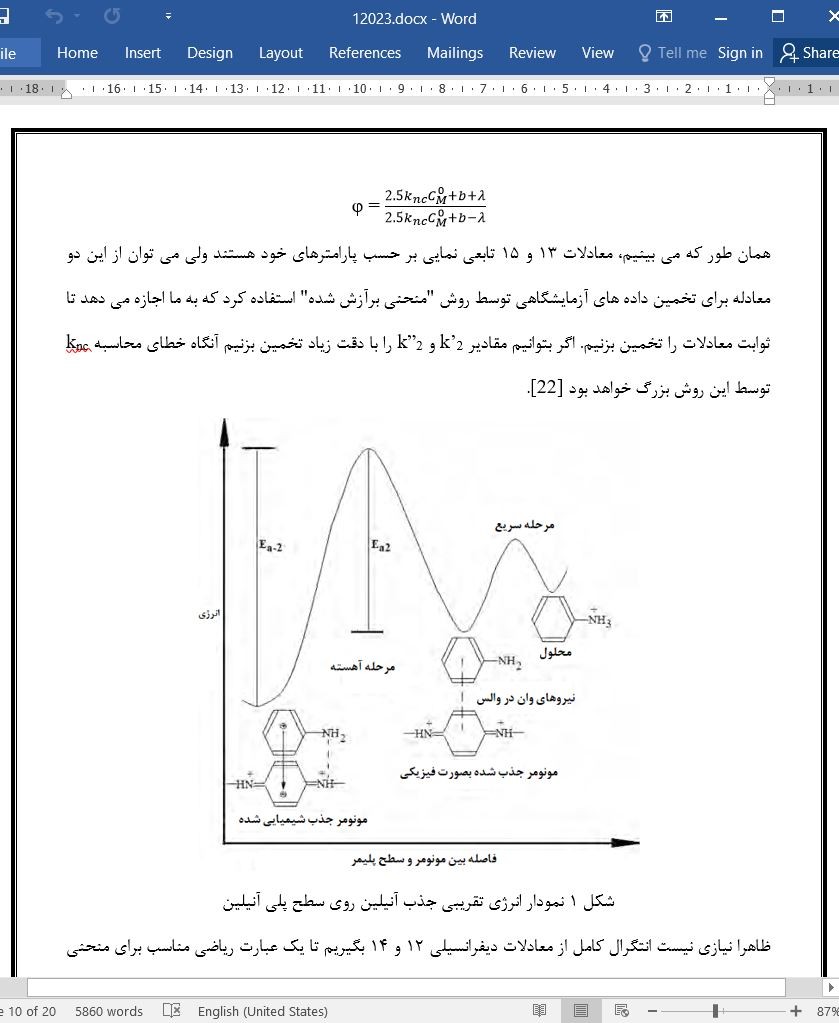
بررسی فرایند پلیمریزاسیون آنیلین به کمک طیف سنجی EPR
چکیده
در این مقاله امکان استفاده از اسپکتروسکوپی EPR برای نظارت بر غلظت پلی آنیلین و کنترل سینتیک واکنش پلیمریزاسیون آنیلین بررسی می شود. اندازه گیری پارامترهای سینتیکی در دماهای مختلف و غلظت های اولیه متفاوت مواد شیمیایی انجام می شد. در تمامی موارد واکنش خودکاتالیزوری مشاهده شد. مشخص شد که درجه اکسیداسیون کاتالیستی پلی آنیلین از مرتبه 1 به مرتبه 2 تغییر می کند و در نتیجه باعث کاهش غلظت مونومر می شود. یک رویکرد جدید برای محاسبه معادله سرعت پلیمریزاسیون اکسایشی آنیلین و مشتقات آن با در نظر گرفتن جذب فیزیکی و شیمیایی مونومرها پیشنهاد می شود و مکانیزم این واکنش نیز بررسی می شود.
1-مقدمه
ترکیبی از رسانایی الکتریکی عالی [1]، پایداری شیمیایی و حرارتی بالا [2-4] باعث شده تا سنتز، خواص [5,6]، کاربرد پلی آنیلین و مشتقات آن [7-9] بطور گسترده مطالعه شود. درک مکانیزم سینتیک پلیمریزاسیون یکی از مهم ترین نکات برای یافتن رابطه بین خواص ماکرومولکول ها و شرایط سنتز آنها است. اگرچه مکانیزم سنتز بسیاری از پلیمرها بررسی شده است ولی ماهیت رشد زنجیر مولکولی در پلیمریزاسیون اکسایشی توجه محققان زیادی را به خود جلب کرده است [10]. اخیرا ماهیت هسته های فعال پلیمریزاسیون اکسایشی آمین های آروماتیک بررسی شده است و ته نشینی رادیکال ها [11]، کاتیون ها [12-14] و کاتیون های رادیکالی [15-17] بعنوان گزینه های جایگزین درنظر گرفته شده اند. فعالیت زیاد مونومرها با ترکیبات اهدا کننده الکترون در پلیمریزاسیون اکسایشی مشتقات آنیلین نشان دهنده تشکیل ذرات با بار مثبت بعنوان ترکیبات واسطه است [18,19]. داده های سینتیک [15-18]، نبود اتصال عرضی در زنجیر مولکولی [20] و ناکارآمدی برخی دام های کاتیونی در برهم کنش ترکیبات واسطه [21] پیشنهاد می دهد که کاتیون های رادیکال آزاد در واقع هسته های فعال پلیمریزاسیون اکسایشی مشتقات آنیلین هستند.
Abstract
The possibility of using EPR spectroscopy to monitor the current concentration of polyaniline and control the kinetics of aniline polymerization is shown. Kinetic measurements were carried out for various temperatures, initial concentrations of reagents. Autocatalysis was detected in all cases. It was shown that the order of polyaniline-catalyzed oxidation of aniline changes from the first to the second as a result of a decrease in the monomer concentration. A new approach to deriving an equation for the rate of oxidative polymerization of aniline and its derivatives is proposed taking into account the physical adsorption and chemisorption of the monomer, and the reaction mechanism is considered.
1. Introduction
The combination of significant electrical conductivity [1], high chemical and thermal stability [2–4] provided an increased interest in the study of synthesis, properties [5,6], directions of application of polyaniline and its derivatives [7–9]. The establishment of the mechanism and kinetics of polymerization is traditionally one of the important points in the search for relationships between the properties of macromolecules and the conditions of their synthesis. Although the mechanism of many classes of polymer synthesis reactions has been established, the nature of chain growth in oxidative polymerization is the subject of numerous discussions in literature [10]. Until recently even the nature of the active centers of the oxidative polymerization of aromatic amines was discussed, and the participation of radicals [11], cations [12–14], and radical cations [15–17] was considered as alternative options. The increased activity of monomers with electron-donor substituents in the oxidative polymerization of aniline derivatives indicates the formation of positively charged particles as intermediates [18,19]. Kinetic data [15–18], the absence of chain cross-linking [20] and the inefficiency of typical cationic “traps” in the interception of intermediates [21] suggest that radical cations are active centers of oxidative polymerization of aniline derivatives.
چکیده
1-مقدمه
2-تجربی
1-2 مواد و روش ها
2-2 مطالعه سینتیک پلیمریزاسیون آنیلین
3- نتایج و بحث
1-3 ملاحظات نظری سینتیک واکنش و مکانیزم پلیمریزاسیون اکسایشی مشتقات آنیلین
2-3 انتگرال گیری از معادله سینتیک بدست آمده برای پلیمریزاسیون اکسایشی مشتقات آنیلین
3-3 طیف های EPR پلی آنیلین و بررسی سینتیک پلیمریزاسیون آنیلین
4-3 تغییر مرتبه غلظت آنیلین
5-3 تاثیر دما روی سرعت پلیمریزاسیون آنیلین
4-نتیجه گیری
منابع
Abstract
1. Introduction
2. Experimental
2.1. Materials and methods
2.2. Study of the kinetics of aniline polymerization
3. Results and discussion
3.1. Theoretical consideration of the kinetics and mechanism of oxidative polymerization of aniline derivatives
3.2. Integration of the kinetic equation for the oxidative polymerization of aniline derivatives
3.3. EPR spectra of polyaniline and registration of the kinetics of aniline polymerization
3.4. Change of order in the concentration of aniline
3.5. Effect of temperature on the rate of polymerization of aniline
4. Conclusion
CRediT authorship contribution statement
Declaration of Competing Interest
Acknowledgements
Funding
Appendix A. Supplementary material
References
- ترجمه فارسی مقاله با فرمت ورد (word) با قابلیت ویرایش، بدون آرم سایت ای ترجمه
- ترجمه فارسی مقاله با فرمت pdf، بدون آرم سایت ای ترجمه



